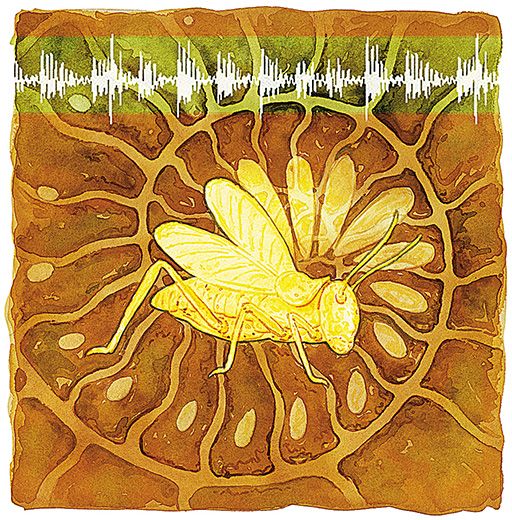How Scientists Are Recreating a Mating Call Last Heard in the Jurassic Period
Preserved in stone, a set of ancient insect wings are “chirping” once again thanks to the work of entomologists
/https://tf-cmsv2-smithsonianmag-media.s3.amazonaws.com/filer/Jurassic-Love-Song-phenomenon-631.jpg)
Every fossil is a time capsule with its own story to tell—or sing. Now paleontologists have listened as never before, recreating an insect song that has not been heard in 165 million years.
Working in northeastern China in a fossil-rich region called the Jiulongshan Formation, Beijing-based paleontologists discovered an exquisite set of insect wings preserved in stone. Microscopic analysis showed they were from a previously unknown species of archaic katydid, a cricket-like creature. Most exciting, the wings had survived the grind of time, so the special structures the presumably male katydid used to sing could still be seen. The researchers named it Archaboilus musicus in tribute to its acoustic talents.
Much like modern katydids, this Jurassic species had two pairs of wings, and even though the fossil insect’s legs were not found, comparisons with closely related katydids hint that it crawled on the ground rather than fly. The male called out to potential mates by rubbing a toothed vein on the edge of one forewing against a sharp-edged scraper under the opposite forewing.
Once the paleontologists and entomologists squared away the anatomy, they turned to Fernando Montealegre-Zapata, an expert on biological sounds at the University of Lincoln in England, who worked to reconstruct the katydid’s song. Studying the shape and size of the wings—including the spacing of the rasplike teeth along the wing edge—and comparing those structures with those of modern katydids, Montealegre-Zapata programmed a computer to produce the most likely sound that the four-inch-long insect could have made. The result, a landmark in paleoacoustics, is the most ancient call ever recreated.
It sounds like a soft metallic ping: not quite like the chirp of a modern katydid, but not an alien sound, either. “It was very emotional hearing the reconstructed sound,” says Montealegre-Zapata. Curiously, A. musicus sang at a relatively low frequency—about 6 kHz—compared with the 10 kHz or greater of most living katydids. That’s a clue to the Jurassic environment of ferns and conifers in which it lived. Among other things, low-frequency sounds carry farther, penetrate underbrush better and are more readily detected amid a din than are high-frequency sounds. “I think if we were able to travel back in time to the Jurassic, we would hear a very noisy environment at night with insect calls perhaps similar to what we hear today but noisier to our ears, as many will be at low frequencies,” Montealegre-Zapata says.
Of course, dangerous eavesdroppers inhabited the same forest. Citing other fossils found in the Jiu- longshan Formation, the researchers point out that reptiles, amphibians, mammals and possibly feathered dinosaurs were known to exist there. Perhaps, then, A. musicus, like today’s katy- dids, remained mostly quiet during the day, calling for mates at night to minimize detection. “In the darkness of the Jurassic forest,” the researchers conclude in a paper published in the Proceedings of the National Academy of Sciences, “A. musicus surely experienced the dilemma of singing loud and clear, while simultaneously attempting to avoid nocturnal predators.”
/https://tf-cmsv2-smithsonianmag-media.s3.amazonaws.com/accounts/headshot/RileyBlack.png)

/https://tf-cmsv2-smithsonianmag-media.s3.amazonaws.com/accounts/headshot/RileyBlack.png)